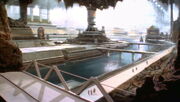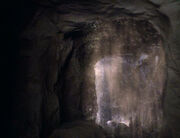No edit summary |
(→Background information: I can find no source for this statement.) |
||
| (7 intermediate revisions by 5 users not shown) | |||
| Line 1: | Line 1: | ||
| − | {{sidebar planet |
+ | {{sidebar planet |
| − | + | |name = Ocampa |
|
| − | | |
+ | |orbital = Generic brown planet.jpg |
| − | | |
+ | |surface = Ocampa surface.jpg |
| − | | |
+ | |class = [[Class M|M]] (formerly) |
| − | | |
+ | |type = [[Planet]] |
| − | | |
+ | |species = [[Ocampa]] |
| − | | |
+ | |location = [[Delta Quadrant]] |
| − | | |
+ | |affiliation = [[Ocampa]]<br>[[Kazon-Ogla]] |
| − | | |
+ | |status = Intact |
| − | | |
+ | |datestatus = 2371 |
}}__NOTOC__ |
}}__NOTOC__ |
||
'''Ocampa''' was an [[inhabited planets|inhabited]] [[fifth planets|fifth]] [[planet]] [[orbit]]ing a [[G-type star|G-type]] [[star]]. Situated near the [[Caretaker's array]], this [[Delta Quadrant]] planet was located approximately 50,000 [[light year]]s from the [[galactic core]] and 75,000 light years from the [[Badlands]] in the [[Alpha Quadrant]]. The [[Ocampa]] were native to this [[homeworld|world]]. |
'''Ocampa''' was an [[inhabited planets|inhabited]] [[fifth planets|fifth]] [[planet]] [[orbit]]ing a [[G-type star|G-type]] [[star]]. Situated near the [[Caretaker's array]], this [[Delta Quadrant]] planet was located approximately 50,000 [[light year]]s from the [[galactic core]] and 75,000 light years from the [[Badlands]] in the [[Alpha Quadrant]]. The [[Ocampa]] were native to this [[homeworld|world]]. |
||
| Line 22: | Line 22: | ||
{{bginfo|Given that Ocampan females enter the ''[[elogium]]'' at age four to five, 500 Ocampan generations might correspond to ca. 2,000 to 2,500 years. A statement by [[Richard James]] seems to corroborate this, as he referred to a set of ruins on the planet's surface as being 2,000 years old (as of [[2371]]). ({{STV|1|71}})}} |
{{bginfo|Given that Ocampan females enter the ''[[elogium]]'' at age four to five, 500 Ocampan generations might correspond to ca. 2,000 to 2,500 years. A statement by [[Richard James]] seems to corroborate this, as he referred to a set of ruins on the planet's surface as being 2,000 years old (as of [[2371]]). ({{STV|1|71}})}} |
||
| − | Although short of [[water]], the planet was rich in [[cormaline]] deposits. The [[Kazon-Ogla]] sect maintained an encampment on the planet's |
+ | Although short of [[water]], the planet was rich in [[cormaline]] deposits. The [[Kazon-Ogla]] sect maintained an encampment on the planet's [[Southern continent of Ocampa|southern continent]], near a dry [[riverbed]] at the foothills of a range of extinct [[volcano]]es to mine its resources. [[Jabin]] was the leader of this encampment in the early [[2370s]]. |
| − | [[File:Ocampa (Fury).jpg|thumb|An image of Ocampa as displayed by a [[ |
+ | [[File:Ocampa (Fury).jpg|thumb|An image of Ocampa as displayed by a [[Class 2 shuttle]]]] |
In 2371, the {{USS|Voyager}} was transported to the area near Ocampa. Shortly before the Caretaker passed away, it was said that the Ocampa had enough surplus energy to keep the city running for [[2376|five years]]. ({{VOY|Caretaker|Before and After}}) At around this time, [[Kes]], a female Ocampa, returned to the planet. ({{VOY|Fury}}) |
In 2371, the {{USS|Voyager}} was transported to the area near Ocampa. Shortly before the Caretaker passed away, it was said that the Ocampa had enough surplus energy to keep the city running for [[2376|five years]]. ({{VOY|Caretaker|Before and After}}) At around this time, [[Kes]], a female Ocampa, returned to the planet. ({{VOY|Fury}}) |
||
== Appendices == |
== Appendices == |
||
=== Appearances === |
=== Appearances === |
||
| − | *{{s| |
+ | *{{s|VOY}} |
**{{e|Caretaker}} ([[VOY Season 1|Season 1]]) |
**{{e|Caretaker}} ([[VOY Season 1|Season 1]]) |
||
**{{e|Before and After}} ([[VOY Season 3|Season 3]]) |
**{{e|Before and After}} ([[VOY Season 3|Season 3]]) |
||
| Line 35: | Line 35: | ||
=== Background information === |
=== Background information === |
||
| − | Due to the premise of {{s| |
+ | Due to the premise of {{s|VOY}}, the Ocampa homeworld could not regularly be shown as a setting in the series. (''[[Star Trek: Voyager - A Vision of the Future]]'', p. 164) Scenes of the underground Ocampa city were filmed at the [[Los Angeles Convention Center]]. {{imdb|title/tt0114530/locations}} The surface scenes were filmed at the [[El Mirage Dry Lake Bed]]. [http://vimeo.com/ondemand/thealphaquadrant/275582733?autoplay=1] |
| + | The underground city on Ocampa was designed by [[Robert Stromberg]]. ("The Art of Alien Worlds", [[VOY Season 4 DVD]] special feature) |
||
| ⚫ | According to ''[[Star Trek: Star Charts]]'' (p. 78), Ocampa (Ocampa V) was classified as a [[Star Trek: Star Charts#Planetary classification|Class H planet]]. Its capital was Ocampa. The dominant species on this planet was the [[humanoid]] Ocampans. In [[2378]], there were an estimated 230.0 million Ocampans living on this world. The planet's surface was devasted by the Nacene in the [[14th century]]. |
||
| + | |||
| ⚫ | According to ''[[Star Trek: Star Charts]]'' (p. 78), Ocampa (Ocampa V) was classified as a [[Star Trek: Star Charts#Planetary classification|Class H planet]]. Its capital was Ocampa. The dominant species on this planet was the [[humanoid]] Ocampans. In [[2378]], there were an estimated 230.0 million Ocampans living on this world.{{incite}} The planet's surface was devasted by the Nacene in the [[14th century]]. |
||
According to ''Star Trek: Star Charts'' (pp. 13 & 82) and ''[[Stellar Cartography: The Starfleet Reference Library]]'' ("Federation Historical Highlights, 2161-2385"), the [[star|primary]] for the Ocampa system was a [[Star Trek: Star Charts#Spectral classification|G-class star]]. This system was located near the [[Vaadwaur]] [[subspace corridor]]s. ''Voyager'' was at this system on [[stardate]] 48317. |
According to ''Star Trek: Star Charts'' (pp. 13 & 82) and ''[[Stellar Cartography: The Starfleet Reference Library]]'' ("Federation Historical Highlights, 2161-2385"), the [[star|primary]] for the Ocampa system was a [[Star Trek: Star Charts#Spectral classification|G-class star]]. This system was located near the [[Vaadwaur]] [[subspace corridor]]s. ''Voyager'' was at this system on [[stardate]] 48317. |
||
Revision as of 20:56, 22 August 2020
Ocampa was an inhabited fifth planet orbiting a G-type star. Situated near the Caretaker's array, this Delta Quadrant planet was located approximately 50,000 light years from the galactic core and 75,000 light years from the Badlands in the Alpha Quadrant. The Ocampa were native to this world.
Ocampa had all the characteristics of a class-M planet, with the sole exception of the absence of nucleogenic particles, which left the planet's atmosphere incapable of producing rain and turned its surface into a desert without a single river or ocean.

The underground city beneath Ocampa's surface

An underground garden

The barrier protecting the Ocampa city
This was not the planet's natural state (in fact, it still had dry riverbeds), but the result of an accident during the exploration of the planet by a group of Nacene ca. 500 Ocampan generations ago. The Ocampa referred to this era as "the Warming". The Nacene took responsibility for their error by constructing a vast underground city, two miles below the surface and protected by security barriers, to give the Ocampa access to the only water left on the planet. The Ocampa were brought to this city by tunnels. They also left behind two members of the exploration team – Suspiria, and an individual who the Ocampa came to know as the Caretaker – to care for the race.
Although short of water, the planet was rich in cormaline deposits. The Kazon-Ogla sect maintained an encampment on the planet's southern continent, near a dry riverbed at the foothills of a range of extinct volcanoes to mine its resources. Jabin was the leader of this encampment in the early 2370s.
An image of Ocampa as displayed by a Class 2 shuttle
In 2371, the USS Voyager was transported to the area near Ocampa. Shortly before the Caretaker passed away, it was said that the Ocampa had enough surplus energy to keep the city running for five years. (VOY: "Caretaker", "Before and After") At around this time, Kes, a female Ocampa, returned to the planet. (VOY: "Fury")
Appendices
Appearances
Background information
Due to the premise of Star Trek: Voyager, the Ocampa homeworld could not regularly be shown as a setting in the series. (Star Trek: Voyager - A Vision of the Future, p. 164) Scenes of the underground Ocampa city were filmed at the Los Angeles Convention Center. [1] The surface scenes were filmed at the El Mirage Dry Lake Bed. [2]
The underground city on Ocampa was designed by Robert Stromberg. ("The Art of Alien Worlds", VOY Season 4 DVD special feature)
According to Star Trek: Star Charts (p. 78), Ocampa (Ocampa V) was classified as a Class H planet. Its capital was Ocampa. The dominant species on this planet was the humanoid Ocampans. In 2378, there were an estimated 230.0 million Ocampans living on this world. (citation needed • edit) The planet's surface was devasted by the Nacene in the 14th century.
According to Star Trek: Star Charts (pp. 13 & 82) and Stellar Cartography: The Starfleet Reference Library ("Federation Historical Highlights, 2161-2385"), the primary for the Ocampa system was a G-class star. This system was located near the Vaadwaur subspace corridors. Voyager was at this system on stardate 48317.
According to StarTrek.com, the Ocampa planet's star was named "Ocampa".
The Star Trek Encyclopedia (4th ed., vol. 2, p. 99) located Ocampa in the Ocampa system.
External link
- Ocampa V at Memory Beta, the wiki for licensed Star Trek works
